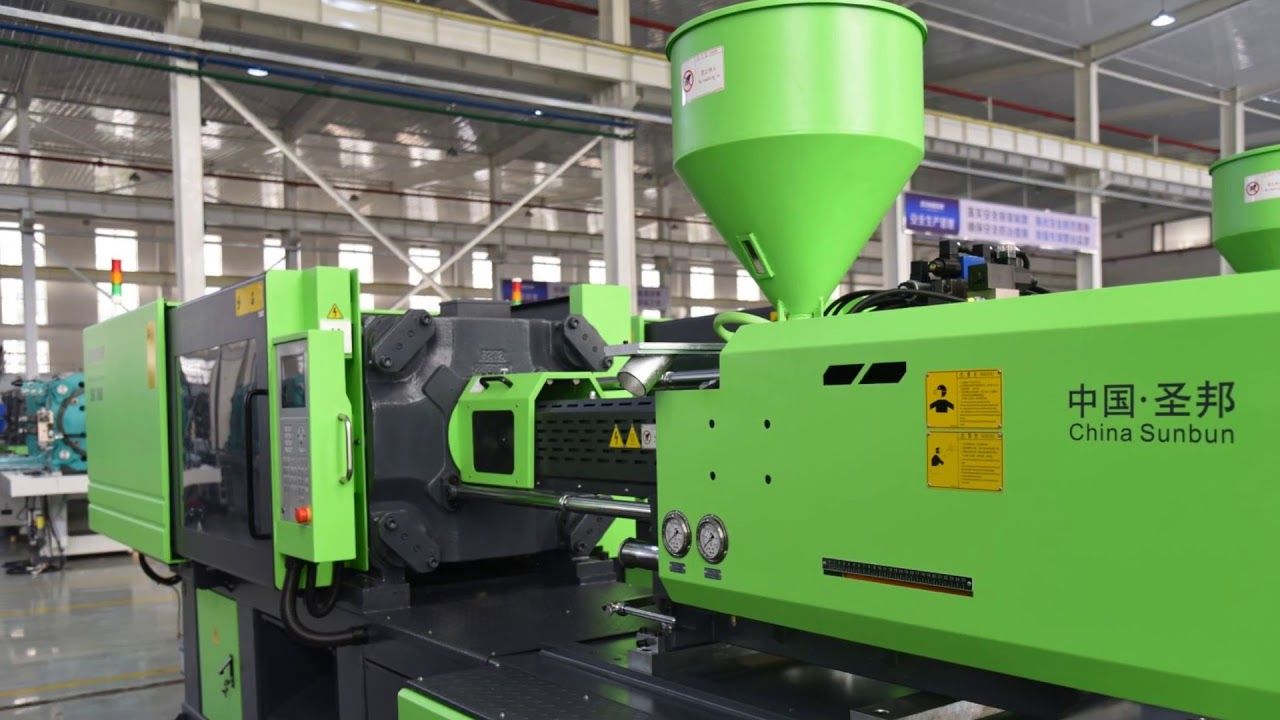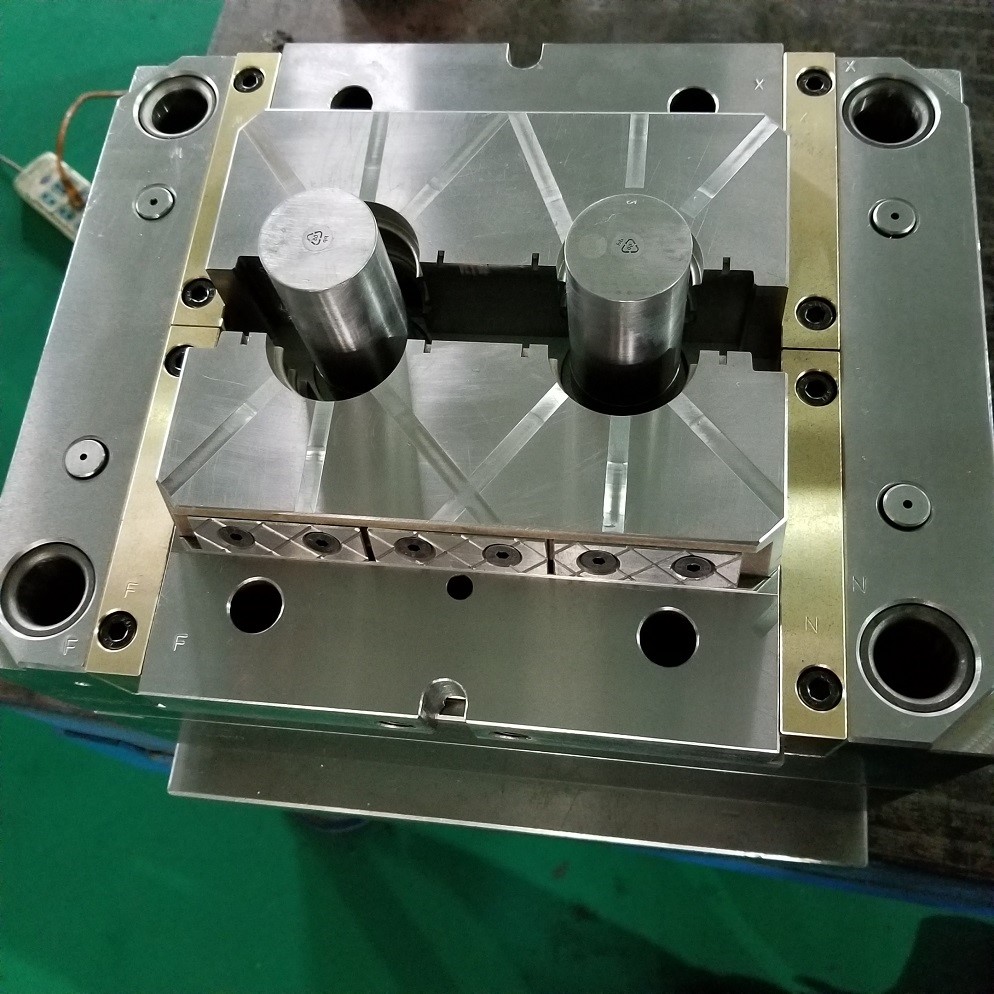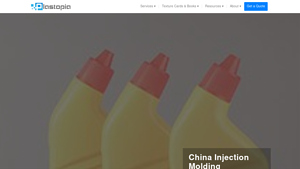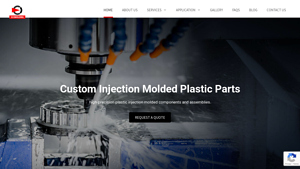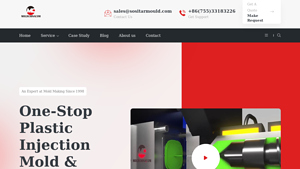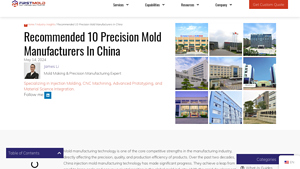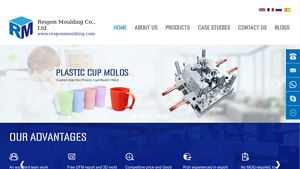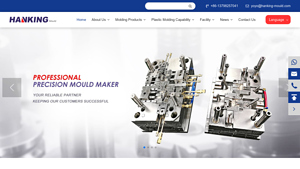Plastic Injection Mould China Guide: Type, Cost, Top List…
Introduction: Navigating the Global Market for plastic injection mould china
In an increasingly competitive landscape, sourcing high-quality plastic injection moulds from China can be daunting for international B2B buyers, especially those in regions like Africa, South America, the Middle East, and Europe. The challenge often lies in navigating the myriad of suppliers, understanding the nuances of pricing, and ensuring that the final products meet stringent quality standards. This guide is designed to demystify the process of sourcing plastic injection moulds from China, providing actionable insights into the types of moulds available, their diverse applications, and effective strategies for supplier vetting.
Buyers will gain a comprehensive understanding of the plastic injection moulding landscape, including critical factors such as cost considerations, lead times, and quality control measures. From startups seeking low-volume production runs to established enterprises looking for cost-effective solutions, this guide offers valuable information tailored to the unique needs of various businesses. By empowering decision-makers with knowledge about material selection, design optimization, and the overall manufacturing process, this resource facilitates informed purchasing decisions that can significantly impact operational efficiency and product quality.
With a clear roadmap laid out, international buyers can confidently engage with Chinese manufacturers, ensuring that they secure the best possible partnerships and achieve their production goals.
Understanding plastic injection mould china Types and Variations
| Type Name | Key Distinguishing Features | Primary B2B Applications | Brief Pros & Cons for Buyers |
|---|---|---|---|
| Single Cavity Mould | Simple design, produces one part per cycle | Consumer goods, automotive components | Pros: Cost-effective for low-volume runs; Cons: Limited production efficiency. |
| Multi-Cavity Mould | Multiple cavities in one mould, producing several parts at once | High-volume production, toys, appliances | Pros: Increased output; Cons: Higher initial costs and complexity. |
| Family Mould | Can produce different parts in one cycle from a single mould | Automotive assemblies, complex products | Pros: Versatile for varied product lines; Cons: Design complexity may lead to increased costs. |
| Overmould | Combines two materials in one process | Electronics, household items | Pros: Enhanced product functionality; Cons: Requires careful material selection. |
| Two-Shot Mould | Allows for two different materials or colors in one part | Medical devices, automotive interiors | Pros: Improved aesthetics and performance; Cons: More complex tooling required. |
What Are the Characteristics of Single Cavity Moulds?
Single cavity moulds are designed to produce a single part per injection cycle, making them ideal for low-volume production runs. They are typically simpler and less expensive to manufacture, which appeals to startups and companies testing new products. However, their limited output capacity means they may not be suitable for businesses needing high-volume production. Buyers should consider their production needs and budget when opting for this type.
How Do Multi-Cavity Moulds Enhance Production Efficiency?
Multi-cavity moulds contain several cavities, allowing manufacturers to produce multiple parts simultaneously. This design is particularly beneficial for high-volume applications, such as toys or household appliances, where consistent quality and reduced cycle times are crucial. While they offer significant efficiency gains, the initial investment is higher, and the complexity of design requires careful planning. Businesses should evaluate their production scale and budget when considering this option.
What Advantages Do Family Moulds Provide for Complex Products?
Family moulds are engineered to produce different parts in a single cycle, making them highly versatile for manufacturers dealing with complex assemblies, such as automotive components. This type of mould can significantly reduce production time and costs associated with managing multiple moulds. However, the design process can be intricate, necessitating a deeper understanding of the parts involved. Buyers should assess their product range and the potential for cost savings when exploring family moulds.
Why Choose Overmoulding for Enhanced Product Functionality?
Overmoulding is a process that combines two different materials to create a single part, enhancing its functionality and durability. This technique is often employed in industries like electronics and household goods, where tactile grip or insulation properties are essential. While overmoulding can improve product performance, it requires careful selection of compatible materials, which can complicate the design process. Companies should weigh the benefits against potential challenges in material selection.
What Are the Key Considerations for Two-Shot Moulds?
Two-shot moulds allow manufacturers to inject two different materials or colors into a single part, resulting in products that are both functional and visually appealing. This method is often used in medical devices and automotive interiors where aesthetics and performance are critical. The complexity of tooling and the need for precise alignment can increase costs, so businesses must ensure that the benefits of enhanced product features justify the investment.
Key Industrial Applications of plastic injection mould china
| Industry/Sector | Specific Application of plastic injection mould china | Value/Benefit for the Business | Key Sourcing Considerations for this Application |
|---|---|---|---|
| Automotive | Production of interior and exterior components | Reduces manufacturing costs and enhances quality | Supplier’s experience in automotive standards and certifications |
| Consumer Electronics | Manufacturing of enclosures and components | Facilitates rapid prototyping and mass production | Material selection and compliance with safety regulations |
| Medical Devices | Creation of precision medical parts | Ensures high-quality, sterile, and reliable products | Certifications like ISO 13485 and FDA compliance |
| Packaging | Design of custom plastic packaging solutions | Increases product shelf life and brand visibility | Flexibility in mold design for various packaging needs |
| Aerospace | Production of lightweight structural components | Reduces weight and improves fuel efficiency | Advanced material capabilities and precision engineering |
How is Plastic Injection Moulding Used in the Automotive Sector?
In the automotive industry, plastic injection moulding is crucial for producing a wide range of components, from dashboard panels to exterior trims. This method allows for the creation of lightweight parts that meet strict safety standards while significantly reducing overall manufacturing costs. International buyers should ensure their suppliers have experience with automotive-grade materials and can provide certifications to meet industry regulations.
What Role Does Plastic Injection Moulding Play in Consumer Electronics?
Consumer electronics heavily rely on plastic injection moulding for the production of enclosures, buttons, and internal components. This technique supports rapid prototyping, allowing companies to bring products to market faster. For buyers, it is essential to consider suppliers that can offer a variety of materials and have a proven track record of adhering to safety and quality standards, ensuring that the final products are both durable and appealing.
Why is Precision Important in Medical Device Manufacturing?
The medical device sector demands the highest precision in manufacturing, making plastic injection moulding a suitable choice for producing components like syringes and surgical instruments. This process ensures high-quality, sterile parts that comply with stringent regulations. Buyers in this field must prioritize suppliers who hold certifications such as ISO 13485 and have experience in producing compliant medical products, as this directly impacts patient safety and product efficacy.
How Can Plastic Injection Moulding Enhance Packaging Solutions?
Plastic injection moulding is widely used in the packaging industry to create custom solutions that enhance product visibility and shelf life. This method allows for intricate designs that can incorporate features such as tamper-proof seals or ergonomic handles. Buyers should look for suppliers who can adapt to various packaging needs and offer flexibility in mold design, ensuring that the final products meet both functional and aesthetic requirements.
What Advantages Does Plastic Injection Moulding Offer in Aerospace Applications?
In the aerospace industry, plastic injection moulding is essential for producing lightweight structural components that contribute to fuel efficiency. The precision of this manufacturing method allows for the creation of complex geometries that meet the rigorous demands of aerospace applications. International buyers should seek suppliers with advanced material capabilities and a strong emphasis on precision engineering to ensure that components meet the necessary performance and safety standards.
3 Common User Pain Points for ‘plastic injection mould china’ & Their Solutions
Scenario 1: Navigating Quality Concerns in Sourcing Injection Molds
The Problem:
B2B buyers often face significant challenges related to the quality of plastic injection molds sourced from China. With varying standards across suppliers, the risk of receiving defective products or molds that do not meet specifications can lead to costly production delays and financial losses. Buyers might also struggle with understanding the specific quality assurance processes of different manufacturers, making it difficult to choose a reliable partner.
The Solution:
To mitigate these quality concerns, buyers should prioritize sourcing from ISO-certified manufacturers that have established quality control protocols. Before finalizing a supplier, conduct a thorough audit of their quality assurance processes. Request detailed documentation of their manufacturing standards, inspection methods, and past performance metrics. It is advisable to ask for samples or prototypes to assess the quality of their work firsthand. Additionally, consider engaging third-party inspection services that can evaluate the molds on-site before shipment, ensuring they meet your specifications. Establishing clear communication regarding quality expectations and conducting regular follow-ups during the production process can also help ensure adherence to required standards.
Scenario 2: Managing Cost Efficiency in Low-Volume Production
The Problem:
International buyers often encounter difficulties when trying to manage costs in low-volume production runs. Many Chinese manufacturers have minimum order quantities that can lead to excess inventory and higher upfront costs for buyers who only require a limited number of parts. This situation is particularly challenging for startups and smaller companies that do not have the capital to invest in large production runs.
The Solution:
To address these cost efficiency issues, buyers should seek manufacturers that specialize in low-volume injection molding. Look for companies that are flexible with their minimum order quantities and offer competitive pricing for smaller runs. Engaging with suppliers that provide a one-stop service—from design to production—can also reduce overall costs by streamlining the process and reducing the need for multiple suppliers. Additionally, consider leveraging digital tools such as online quote systems that allow for quick comparisons across different manufacturers. Building a strong relationship with your supplier can also lead to more favorable terms, such as volume discounts on future orders as your business scales.
Scenario 3: Overcoming Communication Barriers with Chinese Suppliers
The Problem:
Communication barriers can pose significant challenges for B2B buyers dealing with Chinese plastic injection mold suppliers. Misunderstandings regarding specifications, timelines, and materials can lead to delays, cost overruns, and ultimately, unsatisfactory outcomes. Buyers may find it challenging to convey their precise needs and expectations, especially if there are language differences or cultural nuances at play.
The Solution:
To facilitate effective communication, it is crucial to establish clear channels and protocols from the outset. Utilize technology to bridge gaps; platforms like Skype, WhatsApp, and WeChat can provide instant messaging options that enhance real-time communication. When discussing project details, make use of visual aids, such as CAD drawings and detailed specifications, to minimize misunderstandings. Additionally, consider hiring a bilingual project manager or a local consultant who can act as an intermediary, ensuring that both parties are aligned on project goals and timelines. Regular progress check-ins and updates can foster a collaborative relationship and keep the project on track, ultimately leading to a successful partnership.
Strategic Material Selection Guide for plastic injection mould china
What Are the Key Properties of Common Materials Used in Plastic Injection Molding in China?
In the realm of plastic injection molding, the choice of material is critical to the performance, durability, and cost-effectiveness of the final product. Below, we analyze four common materials used in this process, focusing on their properties, advantages, disadvantages, and considerations for international B2B buyers.
1. Polypropylene (PP)
Key Properties: Polypropylene is known for its excellent chemical resistance and low density. It can withstand temperatures up to 100°C and has a good impact resistance, making it suitable for various applications.
Pros & Cons: The primary advantages of PP include its low cost and ease of processing, which leads to shorter cycle times. However, it has lower strength and stiffness compared to other materials, which may limit its use in high-stress applications.
Impact on Application: PP is compatible with a wide range of media, making it ideal for packaging, automotive parts, and consumer goods. However, it may not be suitable for applications requiring high-temperature resistance.
Considerations for International Buyers: Compliance with ASTM standards is essential, especially for buyers in Europe and the Middle East. Buyers should also consider the availability of recycled PP, which is increasingly preferred in markets focused on sustainability.
2. Acrylonitrile Butadiene Styrene (ABS)
Key Properties: ABS offers high impact resistance and toughness, along with good dimensional stability. It can handle temperatures up to 80°C and provides excellent surface finish.
Pros & Cons: The material is versatile and can be easily painted or glued, making it suitable for aesthetic applications. However, ABS is more expensive than PP and may require more complex processing techniques, which can increase production costs.
Impact on Application: ABS is commonly used in consumer electronics, automotive components, and toys due to its strength and aesthetic appeal. Its compatibility with various media makes it a go-to choice for many industries.
Considerations for International Buyers: Buyers should ensure that ABS products meet relevant safety standards, particularly in Europe where regulations are stringent. Understanding the supply chain for ABS is also crucial, as its availability can fluctuate based on global demand.
3. Polycarbonate (PC)
Key Properties: Polycarbonate is known for its exceptional impact resistance and transparency. It can withstand temperatures up to 135°C and is resistant to UV radiation, making it suitable for outdoor applications.
Pros & Cons: The primary advantage of PC is its durability and clarity, which makes it ideal for applications like safety goggles and light covers. However, it is more expensive than both PP and ABS, and its processing can be more complex due to its high viscosity.
Impact on Application: PC is often used in applications requiring high strength and transparency, such as in automotive and electronic components. Its ability to withstand harsh environments makes it suitable for outdoor use.
Considerations for International Buyers: Compliance with international standards such as DIN and JIS is crucial for buyers in Africa and South America. Buyers should also assess the environmental impact of PC, as it is not biodegradable.
4. Nylon (Polyamide)
Key Properties: Nylon is known for its high strength, durability, and resistance to abrasion. It can handle temperatures up to 120°C and has excellent chemical resistance.
Pros & Cons: The key advantage of nylon is its toughness and flexibility, making it suitable for mechanical parts. However, it can be more expensive and may absorb moisture, which can affect its dimensional stability.
Impact on Application: Nylon is commonly used in automotive and industrial applications where strength and durability are paramount. Its compatibility with various chemicals makes it a preferred choice for engineering components.
Considerations for International Buyers: Buyers should be aware of the specific grades of nylon that meet their application needs and ensure compliance with international quality standards. Understanding the implications of moisture absorption is also crucial for maintaining product integrity.
Summary Table of Material Selection for Plastic Injection Molding
| Material | Typical Use Case for plastic injection mould china | Key Advantage | Key Disadvantage/Limitation | Relative Cost (Low/Med/High) |
|---|---|---|---|---|
| Polypropylene (PP) | Packaging, automotive parts, consumer goods | Low cost and easy processing | Lower strength and stiffness | Low |
| Acrylonitrile Butadiene Styrene (ABS) | Consumer electronics, automotive components, toys | High impact resistance and aesthetic finish | More expensive and complex processing | Medium |
| Polycarbonate (PC) | Safety goggles, light covers, outdoor applications | Exceptional impact resistance | Higher cost and complex processing | High |
| Nylon (Polyamide) | Automotive and industrial components | High strength and durability | More expensive and moisture absorption | Medium |
This guide serves as a comprehensive overview for international B2B buyers seeking to make informed decisions regarding material selection for plastic injection molding projects in China. Understanding these materials’ properties and implications will facilitate better product performance and compliance with international standards.
In-depth Look: Manufacturing Processes and Quality Assurance for plastic injection mould china
What Are the Main Stages of Manufacturing Plastic Injection Moulds in China?
The manufacturing process for plastic injection moulds in China encompasses several critical stages, each contributing to the overall quality and efficiency of the final product. Understanding these stages allows B2B buyers to better appreciate the complexity and precision required in creating high-quality moulds.
Material Preparation: What Is Involved?
The first step in the manufacturing process is material preparation. High-quality thermoplastics, such as ABS, polycarbonate, and nylon, are selected based on the specific requirements of the mould and the end product. The choice of material influences the strength, flexibility, and durability of the final product.
Once the materials are chosen, they are prepped by drying to eliminate moisture, which can adversely affect the injection moulding process. This step is crucial, as moisture can lead to defects such as bubbles and poor surface finish.
Forming: How Is the Mould Created?
The forming stage involves the actual creation of the mould, typically through a process known as injection moulding. The prepared plastic granules are heated until they become molten and are then injected into the mould cavity under high pressure.
Precision machining techniques are employed to ensure that the mould meets the design specifications, with tolerances often reaching ±0.002 mm for moulds and ±0.005 mm for parts. This level of precision is vital for ensuring that parts fit together correctly and function as intended.
Assembly: What Happens After Moulding?
After the moulding process, the components may require assembly. This involves fitting together various parts that may have been produced separately. For complex products, additional processes such as overmoulding or insert moulding may be used, where multiple materials are combined to create a single piece.
At this stage, quality checks are performed to ensure that each component meets specified tolerances and quality standards. Assembly can also involve additional finishing processes, such as surface treatments or painting, to enhance the aesthetic appeal or functionality of the product.
Finishing: What Techniques Are Used?
The finishing stage includes several techniques to ensure that the final product meets the desired specifications. This can involve sanding, polishing, or applying coatings to improve surface quality and durability.
For products that require specific surface textures, techniques such as bead blasting or chemical etching may be used. These finishing touches not only enhance the visual appeal but also contribute to the product’s resistance to wear and environmental factors.
What Quality Assurance Measures Are Commonly Implemented?
Quality assurance (QA) is paramount in the plastic injection moulding industry, especially for international B2B buyers. A robust QA process ensures that products not only meet client specifications but also comply with international standards.
Which International Standards Are Relevant?
Many Chinese manufacturers adhere to internationally recognized quality standards, such as ISO 9001:2015, which focuses on quality management systems. This certification ensures that the manufacturer has established processes to consistently deliver products that meet customer and regulatory requirements.
In addition to ISO certifications, industry-specific standards such as CE marking for European markets or API specifications for the oil and gas industry may also apply. B2B buyers should inquire about these certifications when selecting a supplier.
What Are the Key Quality Control Checkpoints?
Quality control typically involves several checkpoints throughout the manufacturing process, including:
-
Incoming Quality Control (IQC): This step involves inspecting raw materials before they enter production. Quality checks ensure that materials meet predefined specifications.
-
In-Process Quality Control (IPQC): During production, periodic checks are conducted to monitor the moulding process and detect any deviations from the established parameters.
-
Final Quality Control (FQC): After production, finished products undergo rigorous testing to ensure they meet all quality standards before being shipped to clients.
What Common Testing Methods Are Used?
Various testing methods are employed to assess the quality of moulded parts, including:
-
Dimensional Inspection: Using precision measuring tools to verify that the dimensions of the moulded parts conform to specifications.
-
Mechanical Testing: Assessing the strength, impact resistance, and flexibility of the plastic materials used.
-
Visual Inspection: Checking for surface defects, color consistency, and overall aesthetics.
These testing methods are essential for ensuring that the final products are reliable and meet customer expectations.
How Can B2B Buyers Verify Supplier Quality Control?
For international B2B buyers, verifying a supplier’s quality control processes is crucial to mitigate risks associated with sourcing. Here are several strategies to ensure quality compliance:
What Should Buyers Look for in Audits and Reports?
Buyers should request access to quality audit reports, which provide insights into the supplier’s quality management systems and practices. Regular audits can reveal the effectiveness of the supplier’s processes and highlight areas for improvement.
How Important Are Third-Party Inspections?
Engaging third-party inspection services can provide an unbiased assessment of the manufacturer’s quality control practices. These inspections can be conducted at various stages of the production process, ensuring compliance with international standards and contractual obligations.
What Are the Quality Control Nuances for International Buyers?
B2B buyers from regions such as Africa, South America, the Middle East, and Europe should be aware of regional regulations and standards that may affect product compliance. Understanding these nuances can help buyers navigate the complexities of international trade and ensure that products meet local market requirements.
By implementing rigorous quality control measures and maintaining open communication with suppliers, B2B buyers can confidently source high-quality plastic injection moulds from China, ultimately ensuring the success of their projects.
Practical Sourcing Guide: A Step-by-Step Checklist for ‘plastic injection mould china’
Introduction
Sourcing plastic injection molds from China can be a strategic move for international B2B buyers looking to optimize production costs and improve product quality. This guide serves as a practical checklist to streamline the procurement process, ensuring that you make informed decisions and establish successful partnerships with suppliers.
Step 1: Define Your Technical Specifications
Before initiating contact with suppliers, clearly outline the technical specifications of your project. This includes dimensions, tolerances, material types, and production volumes. A well-defined specification helps to minimize misunderstandings and ensures that potential suppliers can meet your requirements accurately.
- Material Selection: Identify the type of plastic that best suits your application, considering factors like strength, flexibility, and temperature resistance.
- Volume Requirements: Determine whether you need low-volume runs or high-volume production, as this will influence supplier selection.
Step 2: Conduct Market Research
Invest time in researching potential suppliers in China. Utilize online platforms, industry forums, and trade shows to gather information on various manufacturers. Understanding the market landscape will help you identify reputable suppliers who specialize in your required mold types.
- Supplier Reviews: Look for customer testimonials and case studies to gauge their reliability and quality.
- Competitor Analysis: Check which suppliers your competitors are using to identify trusted manufacturers.
Step 3: Evaluate Potential Suppliers
Before committing, it’s crucial to vet suppliers thoroughly. Request company profiles, case studies, and references from buyers in a similar industry or region. Don’t just rely on their website.
- Certifications: Verify if the supplier holds relevant certifications, such as ISO 9001, which indicates a commitment to quality management.
- Quality Control Systems: Inquire about their quality control processes to ensure consistency and reliability in production.
Step 4: Request Quotes and Compare Costs
Once you’ve shortlisted potential suppliers, request detailed quotes. Compare not just the prices but also the terms of service, including lead times, payment terms, and shipping costs.
- Cost Breakdown: Ensure that the quote includes a breakdown of costs for tooling, production, and any additional services.
- Hidden Fees: Be wary of potential hidden costs that could inflate the overall price.
Step 5: Assess Communication and Support
Effective communication is vital for a successful partnership. Evaluate how responsive and helpful suppliers are during the inquiry stage. This will give you insight into their customer service capabilities.
- Language Proficiency: Ensure that communication can be conducted in a language you are comfortable with to avoid misunderstandings.
- Support Services: Check if they offer support services, such as design analysis and material selection, which can be beneficial for first-time buyers.
Step 6: Negotiate Terms and Finalize Agreement
Once you’ve selected a supplier, negotiate terms that align with your business objectives. This includes delivery schedules, payment terms, and quality assurance guarantees.
- Contract Clarity: Ensure that all agreed-upon terms are documented clearly in a contract to protect both parties.
- Flexibility: Discuss potential for adjustments in production volume or design changes as your project evolves.
Step 7: Plan for Quality Assurance and After-Sales Support
After placing an order, establish a plan for quality assurance and after-sales support. This will help address any issues promptly and maintain a strong relationship with your supplier.
- Inspection Protocols: Implement inspection protocols to ensure that the molds meet your specifications before shipment.
- After-Sales Service: Confirm that the supplier offers after-sales support for troubleshooting and maintenance of the molds.
By following this checklist, you can navigate the complexities of sourcing plastic injection molds from China, ensuring a successful procurement process and a fruitful partnership with your supplier.
Comprehensive Cost and Pricing Analysis for plastic injection mould china Sourcing
What Are the Key Cost Components in Plastic Injection Molding from China?
Understanding the cost structure of plastic injection molding in China is essential for international B2B buyers. The main components of cost include:
-
Materials: The choice of plastic resin significantly influences pricing. Common materials such as ABS, PP, and PC have varying costs based on market demand and availability. High-performance or specialty materials will increase the overall cost.
-
Labor: Labor costs in China are generally lower than in Western countries, but this can vary by region. Skilled labor is essential for quality assurance and precision, impacting the overall manufacturing cost.
-
Manufacturing Overhead: This includes expenses such as utilities, equipment maintenance, and factory management. Efficient production facilities with advanced technology can help reduce overhead costs.
-
Tooling: Tooling costs can range from a few thousand to tens of thousands of dollars depending on the complexity of the mold. A well-designed mold can reduce cycle times and improve production efficiency, ultimately lowering costs per unit.
-
Quality Control (QC): Investing in quality control processes ensures that products meet specifications and reduce defects. This may include testing, inspections, and certifications, which can add to upfront costs but save money in the long run by minimizing returns and rework.
-
Logistics: Shipping costs from China can be significant, especially with rising freight rates. Factors such as shipping method (air vs. sea), destination, and Incoterms affect overall logistics expenses.
-
Margin: Suppliers typically include a profit margin in their pricing. Understanding the market and being aware of average margins can help in negotiations.
How Do Price Influencers Impact B2B Sourcing Decisions?
Several factors can influence pricing in the plastic injection molding sector:
-
Volume and Minimum Order Quantity (MOQ): Higher volumes typically lead to lower per-unit costs. Suppliers often offer tiered pricing based on order size, which can be crucial for budget management.
-
Specifications and Customization: Custom designs and specifications may incur additional costs. Buyers should clarify their requirements upfront to avoid unexpected charges.
-
Material Choices: The selection of materials impacts both the cost and functionality of the final product. Buyers should consider not only the initial price but also the performance characteristics of the materials used.
-
Quality and Certifications: Compliance with international quality standards (e.g., ISO certifications) can affect pricing. Suppliers with recognized certifications may charge a premium, but they often provide greater reliability and assurance of quality.
-
Supplier Factors: Supplier reputation, experience, and production capacity can influence pricing. Established suppliers with a track record of successful projects may command higher prices but offer more reliability.
-
Incoterms: The agreed-upon Incoterms determine who is responsible for shipping costs and risks, which can significantly affect total costs.
What Are the Best Buyer Tips for Cost-Efficiency in China?
-
Negotiate Pricing: Always enter negotiations with a clear understanding of market rates and pricing structures. Suppliers may be willing to lower prices for larger orders or long-term contracts.
-
Consider Total Cost of Ownership (TCO): Evaluate the TCO, which includes not just the purchase price but also shipping, handling, potential tariffs, and long-term operational costs. This holistic view can prevent unexpected expenses.
-
Leverage Volume Discounts: If possible, consolidate orders to meet MOQ requirements. Larger orders often qualify for significant discounts, reducing overall costs.
-
Request Detailed Quotations: Obtain itemized quotes that break down all costs. This transparency helps in comparing suppliers and understanding where savings can be made.
-
Understand Pricing Nuances for International Sourcing: Familiarize yourself with local regulations and potential tariffs that may apply when importing goods from China to your region. This knowledge can help in budgeting and avoiding costly surprises.
Conclusion
While sourcing plastic injection molds from China can offer significant cost advantages, understanding the underlying cost structure and pricing influencers is critical for making informed decisions. By focusing on key components and leveraging negotiation strategies, international buyers can optimize their sourcing strategies and achieve better overall value. Always remember that indicative prices can vary based on market conditions, so continuous market research is advised.
Alternatives Analysis: Comparing plastic injection mould china With Other Solutions
Exploring Alternatives to Plastic Injection Moulding in China
When considering manufacturing solutions for plastic components, it’s essential to explore alternatives to plastic injection moulding in China. Each option presents unique advantages and drawbacks, depending on the specific needs of your business. This analysis will compare ‘Plastic Injection Mould China’ against two viable alternatives: 3D Printing and Blow Moulding.
Comparison Table
| Comparison Aspect | Plastic Injection Mould China | 3D Printing | Blow Moulding |
|---|---|---|---|
| Performance | High precision and efficiency | Good for prototypes, less for mass production | High efficiency for hollow parts |
| Cost | Moderate initial costs; low for high volumes | High per unit for mass production, lower for low volumes | Cost-effective for large quantities |
| Ease of Implementation | Requires tooling and setup | Quick setup, no tooling needed | Moderate setup time; requires moulds |
| Maintenance | Regular maintenance of moulds | Minimal maintenance | Moderate maintenance of machinery |
| Best Use Case | Large production runs | Prototyping and small batches | Hollow plastic parts in large volumes |
In-Depth Analysis of Alternatives
What are the Benefits and Drawbacks of 3D Printing?
3D printing, also known as additive manufacturing, offers a flexible and rapid prototyping solution. It allows for quick iterations and modifications without the need for expensive moulds, making it an ideal choice for startups and companies testing new designs. However, while 3D printing excels in low-volume production and complex geometries, it can become costly for larger production runs due to longer production times and higher material costs. Therefore, while it is a fantastic tool for innovation, it may not be the best choice for companies focused on high-volume manufacturing.
How Does Blow Moulding Compare?
Blow moulding is another alternative that specializes in creating hollow plastic parts, such as bottles and containers. It is a highly efficient method for mass production and can offer lower costs per unit when producing large quantities. However, the initial setup requires a significant investment in moulds and machinery, which can be a barrier for smaller companies. Additionally, blow moulding is limited to specific shapes, which may not suit all product designs. Thus, it is best suited for businesses that require high-volume production of standardized hollow products.
Making the Right Choice for Your Manufacturing Needs
Choosing the right manufacturing solution hinges on your specific requirements, including production volume, design complexity, and budget constraints. If you anticipate high-volume production of intricate designs, plastic injection moulding in China remains a robust choice due to its precision and cost-effectiveness at scale. However, if your focus is on prototyping or small-batch production, consider 3D printing for its flexibility. For businesses looking to produce hollow products in bulk, blow moulding may provide the best cost efficiency.
In conclusion, understanding the strengths and weaknesses of each alternative will empower B2B buyers to make informed decisions that align with their operational goals and market demands.
Essential Technical Properties and Trade Terminology for plastic injection mould china
What Are the Key Technical Properties of Plastic Injection Molds in China?
Understanding the essential technical properties of plastic injection molds is crucial for international B2B buyers to ensure they select the right solutions for their manufacturing needs. Here are several critical specifications:
-
Material Grade
The choice of material for injection molds significantly affects durability, performance, and cost. Common materials include steel (P20, H13) and aluminum, each offering distinct advantages. Steel molds are ideal for high-volume production due to their longevity, while aluminum molds are suited for low-volume runs and quicker turnarounds. -
Tolerance
Tolerance refers to the permissible limit of variation in a physical dimension. In the plastic injection molding industry, tight tolerances (e.g., ±0.002mm for molds, ±0.005mm for parts) are critical for ensuring parts fit correctly and function as intended. High precision reduces the need for post-processing, thereby lowering overall costs and improving time-to-market. -
Cycle Time
Cycle time is the total time required to produce one part, including injection, cooling, and ejection phases. Shorter cycle times enhance productivity and reduce costs, making it vital for manufacturers to optimize their processes. Buyers should inquire about average cycle times to assess potential production efficiency. -
Cavity Count
This refers to the number of identical parts that can be produced in one cycle of the mold. Molds can be single-cavity or multi-cavity (e.g., 4, 8, 16 cavities). The choice impacts production efficiency and cost-effectiveness, as multi-cavity molds can produce more parts simultaneously, lowering per-unit costs. -
Surface Finish
The surface finish of molded parts affects both aesthetics and functionality. It is categorized into various grades, such as mirror finish or textured finish. Buyers should specify surface finish requirements early in the design process to ensure the final product meets market expectations. -
Durability and Wear Resistance
The durability of a mold is determined by its ability to withstand repeated use without degradation. Materials with high wear resistance, such as hardened steel, are preferred for long production runs. Understanding durability helps buyers assess mold life and associated replacement costs.
What Are Common Trade Terms in Plastic Injection Molding?
Familiarity with industry jargon is essential for effective communication and negotiation in the plastic injection molding sector. Here are some key terms:
-
OEM (Original Equipment Manufacturer)
An OEM produces components that are used in another company’s end products. Understanding OEM relationships is critical for buyers looking for customized solutions or specific branding in their products. -
MOQ (Minimum Order Quantity)
MOQ refers to the smallest order size that a supplier is willing to accept. This term is significant for budgeting and planning, as it influences inventory levels and cash flow, especially for startups or businesses entering new markets. -
RFQ (Request for Quotation)
An RFQ is a document issued by a buyer to solicit price quotes from suppliers for specific products or services. This process is essential for comparing prices, terms, and capabilities among different manufacturers. -
Incoterms (International Commercial Terms)
These are a series of predefined commercial terms published by the International Chamber of Commerce (ICC) that outline the responsibilities of buyers and sellers in international transactions. Understanding Incoterms helps clarify shipping responsibilities, risk, and costs, which is critical for cross-border transactions. -
DFM (Design for Manufacturing)
DFM is an engineering practice that focuses on designing products in such a way that they are easy to manufacture. By incorporating DFM principles, buyers can reduce production costs and improve product quality, leading to better overall performance. -
Lead Time
Lead time refers to the total time from the initiation of a project to its completion. This includes design, tooling, and production phases. Understanding lead time is crucial for buyers to align their product launch schedules with manufacturing capabilities.
By grasping these technical properties and trade terminologies, B2B buyers can navigate the complexities of sourcing plastic injection molds from China more effectively, ensuring they make informed decisions that align with their operational and financial goals.
Navigating Market Dynamics and Sourcing Trends in the plastic injection mould china Sector
What Are the Current Market Dynamics in the Plastic Injection Mould Sector in China?
The plastic injection mould sector in China continues to be a pivotal player in global manufacturing, driven by several key factors. A significant driver is the increasing demand for customized plastic components across various industries, including automotive, electronics, and consumer goods. International B2B buyers, particularly from Africa, South America, the Middle East, and Europe, are looking for cost-effective solutions without compromising on quality. This demand is coupled with the rapid technological advancements in injection moulding processes, such as the integration of Industry 4.0 technologies, including IoT and AI, which optimize production efficiency and reduce lead times.
Emerging sourcing trends indicate a shift towards low-volume production runs, catering to startups and small businesses that require flexibility in their manufacturing processes. Companies like Plastopia and ACE Mold are adapting to this trend by offering scalable solutions that accommodate varying production needs. Moreover, the emphasis on quick turnaround times, often within weeks, has become a standard expectation among international buyers, enhancing competitiveness in this sector.
How Is Sustainability Influencing B2B Sourcing Decisions in Plastic Injection Moulding?
Sustainability has emerged as a crucial factor influencing B2B sourcing decisions in the plastic injection moulding industry. The environmental impact of plastic production has prompted buyers to seek out suppliers who prioritize sustainable practices. This includes the use of recycled materials, biodegradable plastics, and energy-efficient manufacturing processes. Companies are increasingly investing in ‘green’ certifications, which not only improve their marketability but also align with the growing consumer demand for environmentally responsible products.
Ethical sourcing is another critical aspect of sustainability. International buyers are focusing on supply chain transparency to ensure that their suppliers adhere to ethical labor practices and environmental regulations. This shift is particularly evident in regions like Europe, where stringent regulations govern the use of plastics and waste management. Suppliers that can demonstrate compliance with these standards and offer sustainable materials are likely to gain a competitive edge in the market.
What Is the Historical Context of the Plastic Injection Moulding Industry in China?
The plastic injection moulding industry in China has evolved significantly over the past few decades. Initially, the sector was characterized by low-cost labor and simple production techniques, which attracted international buyers seeking cost-effective manufacturing solutions. As China’s economy grew, so did its technological capabilities, leading to advancements in precision moulding and automation.
By the early 2000s, China had established itself as a global hub for plastic injection moulding, thanks to its robust supply chains and skilled workforce. Today, the industry is marked by a focus on innovation, quality control, and sustainability, positioning itself as a leader in the global market. This evolution reflects the increasing sophistication of international buyers who demand not just low prices, but also high-quality, sustainable products. As the market continues to mature, Chinese manufacturers are poised to meet these evolving demands with enhanced efficiency and responsibility.
Frequently Asked Questions (FAQs) for B2B Buyers of plastic injection mould china
-
1. How do I solve quality control issues when sourcing plastic injection molds from China?
To address quality control challenges, establish clear communication with your Chinese supplier regarding your specifications and quality standards from the outset. Request detailed quality assurance (QA) protocols, including reports and sample inspections before full production. Consider visiting the factory or hiring a third-party inspection service to evaluate the molds during production and before shipment. This proactive approach helps ensure that the molds meet your requirements and minimizes the risk of defects. -
2. What is the best way to assess a plastic injection mold supplier in China?
Evaluate potential suppliers by examining their experience, certifications (such as ISO 9001), and past project portfolios. Request references from previous clients to gauge their reliability and quality of service. It’s also beneficial to conduct virtual meetings or site visits to discuss your project in detail and assess their manufacturing capabilities firsthand. Additionally, consider their responsiveness to inquiries and willingness to provide detailed information about their processes and materials. -
3. What are the typical minimum order quantities (MOQs) for plastic injection molds from China?
MOQs can vary significantly depending on the supplier and the complexity of the mold. Typically, MOQs range from 100 to 1,000 units for production runs. Some suppliers may accommodate lower volumes, especially for startups or prototype testing. Discuss your specific needs with the supplier to find a mutually agreeable MOQ that aligns with your budget and production goals. -
4. How can I customize my plastic injection molds to meet specific needs?
Customization starts with a clear design brief outlining your product requirements, including dimensions, materials, and functionality. Collaborate with your supplier’s design team for mold design analysis and optimization, which may include features like multi-cavity molds or overmolding. Utilize CAD software to visualize your design and ensure all aspects are achievable within the injection molding process. Regular communication throughout the design and production phases is crucial to achieving the desired customization. -
5. What payment terms are commonly accepted when working with Chinese suppliers?
Standard payment terms include a deposit (usually 30-50%) before production, with the balance paid before shipping. Some suppliers may offer payment via letter of credit for larger orders, providing additional security. It’s essential to discuss and agree upon payment terms upfront to avoid misunderstandings. Additionally, consider using a secure payment platform that offers buyer protection to mitigate risks associated with international transactions. -
6. How do I handle logistics and shipping when importing molds from China?
Coordinate with your supplier to determine the best shipping method based on your timeline and budget. Options may include air freight for faster delivery or sea freight for cost savings. Ensure you understand the incoterms (like FOB or CIF) and who is responsible for customs clearance and duties. Engaging a freight forwarder can simplify logistics, as they can manage shipping arrangements and handle documentation to ensure a smooth import process. -
7. What types of materials can be used for plastic injection molding, and how do I choose the right one?
Common materials include ABS, polypropylene, polycarbonate, and nylon, each offering unique properties suited for different applications. Consider factors like strength, temperature resistance, and intended use when selecting a material. Your supplier can provide guidance based on their expertise and the specific requirements of your project. It’s also wise to request samples to test material performance before committing to a final choice. -
8. What should I expect during the mold design and production process?
The process typically involves several stages: initial design consultation, CAD modeling, mold fabrication, and sample testing. After you provide your specifications, the supplier will create a mold design and conduct a design for manufacturability (DFM) analysis. Once approved, they will produce the mold and provide sample parts for your review. Expect regular updates and opportunities for feedback to ensure that the final product aligns with your expectations before mass production begins.
Important Disclaimer & Terms of Use
⚠️ Important Disclaimer
The information provided in this guide, including content regarding manufacturers, technical specifications, and market analysis, is for informational and educational purposes only. It does not constitute professional procurement advice, financial advice, or legal advice.
While we have made every effort to ensure the accuracy and timeliness of the information, we are not responsible for any errors, omissions, or outdated information. Market conditions, company details, and technical standards are subject to change.
B2B buyers must conduct their own independent and thorough due diligence before making any purchasing decisions. This includes contacting suppliers directly, verifying certifications, requesting samples, and seeking professional consultation. The risk of relying on any information in this guide is borne solely by the reader.
Top 7 Plastic Injection Mould China Manufacturers & Suppliers List
1. Plastopia – Molding Services & Custom Solutions
Domain: plastopialtd.com
Registered: 2015 (10 years)
Introduction: Plastopia offers a variety of molding services including:
– Plastics Injection Molding
– Micro Injection Molding
– Silicone Molding
– Blow Molding
– Extrusion Molding
– Vacuum Forming
– Metal Zinc Die Casting
– CNC Machining
– Custom Metal Parts
Value-added services include:
– 3D Printing Service
– Product Design
Texture Cards & Books:
– Plastopia™ VDI 3400 Texture Card (VDI #12~45…
2. Ecomolding – Precision Plastic Injection Molding
Domain: ecomolding.com
Registered: 2014 (11 years)
Introduction: This company, Ecomolding – Precision Plastic Injection Molding, is a notable entity in the market. For specific product details, it is recommended to visit their website directly.
3. Ace Mold – Key Product
Domain: ace-mold.com
Registered: 2020 (5 years)
Introduction: Key Product Details: 1. Services Offered: Mould Design, Mould Making, Injection Moulding, Die Casting Service, Precision CNC Components, Blow Molding. 2. Types of Moulds: High Precision Mould, Aerospace Plastic Injection Parts, Automotive Plastic Injection Parts, Cosmetics Plastic Injection Parts, Engineering Plastic Injection Parts, Home Appliance & Office Plastic Injection Moulding, Medical Plas…
4. Mold China – Plastic Injection Molding Solutions
Domain: moldchina.com
Registered: 2004 (21 years)
Introduction: This company, Mold China – Plastic Injection Molding Solutions, is a notable entity in the market. For specific product details, it is recommended to visit their website directly.
5. FirstMold – Specialized Molds for Automotive and Aerospace
Domain: firstmold.com
Registered: 2016 (9 years)
Introduction: Mold Types: Injection molds, die-casting molds; Industries: Automotive, aerospace, medical, consumer electronics; Headquarters: Zhongshan, Guangdong; Established: 2011; Factory Area: Over 30,000 square meters; Specialization: Automotive molds, aerospace molds, consumer electronics molds, multi-industry injection molded product production, aluminum product models, plastic hardware parts; Services: …
6. Respon Moulding – Rapid Tooling & Injection Molding Services
Domain: responmoulding.com
Registered: 2019 (6 years)
Introduction: This company, Respon Moulding – Rapid Tooling & Injection Molding Services, is a notable entity in the market. For specific product details, it is recommended to visit their website directly.
7. Hanking Mould – Plastic Injection Moulds
Domain: hanking-mould.com
Registered: 2010 (15 years)
Introduction: Hanking Mould is a professional plastic injection mould manufacturer based in China, offering a wide range of services and products including: 1. Plastic Injection Moulds 2. Micro Injection Mold 3. Precision Mould 4. Automotive Mold 5. Electronics Mould 6. 2K Mould 7. Home Appliance Mould 8. Multi Cavity Mould 9. Industrial Mould 10. Insert Molding 11. Medical Mould 12. Prototype Mould 13. Custom …
Strategic Sourcing Conclusion and Outlook for plastic injection mould china
As international B2B buyers navigate the landscape of plastic injection molding in China, strategic sourcing emerges as a pivotal approach to ensure success. Engaging with experienced manufacturers who prioritize quality control, efficient production timelines, and cost-effectiveness is essential. Companies like Plastopia, ACE Mold, and Topworks exemplify the benefits of a one-stop solution, offering comprehensive services from design consultation to final assembly.
Buyers should leverage the low-volume production capabilities available, which cater specifically to startups and smaller enterprises. Understanding material specifications and mold design optimization can significantly enhance product outcomes and reduce time-to-market. Moreover, the emphasis on robust after-sales support ensures that any post-production needs are swiftly addressed, fostering long-term partnerships.
Looking ahead, the demand for high-quality, cost-efficient plastic components will only increase, making it imperative for buyers from Africa, South America, the Middle East, and Europe to seize opportunities in the Chinese market. By prioritizing strategic sourcing, businesses can not only enhance their supply chain resilience but also unlock new avenues for growth. Now is the time to engage with trusted partners in China to drive innovation and success in your projects.
